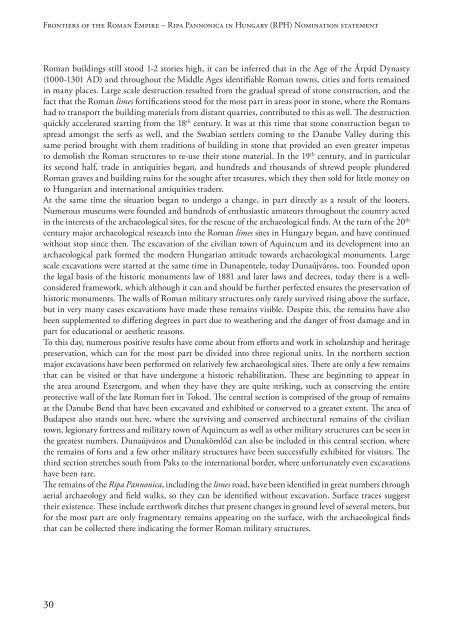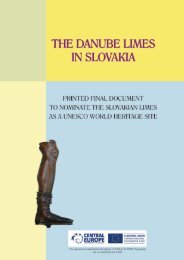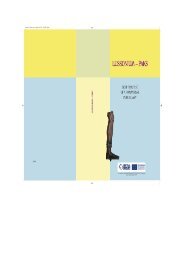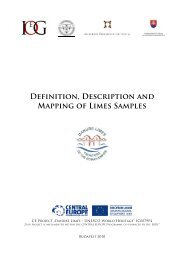the PDF version! - Danube Limes
the PDF version! - Danube Limes
the PDF version! - Danube Limes
Create successful ePaper yourself
Turn your PDF publications into a flip-book with our unique Google optimized e-Paper software.
Frontiers of <strong>the</strong> Roman Empire – Ripa Pannonica in Hungary (RPH) Nomination statement<br />
Roman buildings still stood 1-2 stories high, it can be inferred that in <strong>the</strong> Age of <strong>the</strong> Árpád Dynasty<br />
(1000-1301 AD) and throughout <strong>the</strong> Middle Ages identifiable Roman towns, cities and forts remained<br />
in many places. Large scale destruction resulted from <strong>the</strong> gradual spread of stone construction, and <strong>the</strong><br />
fact that <strong>the</strong> Roman limes fortifications stood for <strong>the</strong> most part in areas poor in stone, where <strong>the</strong> Romans<br />
had to transport <strong>the</strong> building materials from distant quarries, contributed to this as well. The destruction<br />
quickly accelerated starting from <strong>the</strong> 18 th century. It was at this time that stone construction began to<br />
spread amongst <strong>the</strong> serfs as well, and <strong>the</strong> Swabian settlers coming to <strong>the</strong> <strong>Danube</strong> Valley during this<br />
same period brought with <strong>the</strong>m traditions of building in stone that provided an even greater impetus<br />
to demolish <strong>the</strong> Roman structures to re-use <strong>the</strong>ir stone material. In <strong>the</strong> 19 th century, and in particular<br />
its second half, trade in antiquities began, and hundreds and thousands of shrewd people plundered<br />
Roman graves and building ruins for <strong>the</strong> sought after treasures, which <strong>the</strong>y <strong>the</strong>n sold for little money on<br />
to Hungarian and international antiquities traders.<br />
At <strong>the</strong> same time <strong>the</strong> situation began to undergo a change, in part directly as a result of <strong>the</strong> looters.<br />
Numerous museums were founded and hundreds of enthusiastic amateurs throughout <strong>the</strong> country acted<br />
in <strong>the</strong> interests of <strong>the</strong> archaeological sites, for <strong>the</strong> rescue of <strong>the</strong> archaeological finds. At <strong>the</strong> turn of <strong>the</strong> 20 th<br />
century major archaeological research into <strong>the</strong> Roman limes sites in Hungary began, and have continued<br />
without stop since <strong>the</strong>n. The excavation of <strong>the</strong> civilian town of Aquincum and its development into an<br />
archaeological park formed <strong>the</strong> modern Hungarian attitude towards archaeological monuments. Large<br />
scale excavations were started at <strong>the</strong> same time in Dunapentele, today Dunaújváros, too. Founded upon<br />
<strong>the</strong> legal basis of <strong>the</strong> historic monuments law of 1881 and later laws and decrees, today <strong>the</strong>re is a wellconsidered<br />
framework, which although it can and should be fur<strong>the</strong>r perfected ensures <strong>the</strong> preservation of<br />
historic monuments. The walls of Roman military structures only rarely survived rising above <strong>the</strong> surface,<br />
but in very many cases excavations have made <strong>the</strong>se remains visible. Despite this, <strong>the</strong> remains have also<br />
been supplemented to differing degrees in part due to wea<strong>the</strong>ring and <strong>the</strong> danger of frost damage and in<br />
part for educational or aes<strong>the</strong>tic reasons.<br />
To this day, numerous positive results have come about from efforts and work in scholarship and heritage<br />
preservation, which can for <strong>the</strong> most part be divided into three regional units. In <strong>the</strong> nor<strong>the</strong>rn section<br />
major excavations have been performed on relatively few archaeological sites. There are only a few remains<br />
that can be visited or that have undergone a historic rehabilitation. These are beginning to appear in<br />
<strong>the</strong> area around Esztergom, and when <strong>the</strong>y have <strong>the</strong>y are quite striking, such as conserving <strong>the</strong> entire<br />
protective wall of <strong>the</strong> late Roman fort in Tokod. The central section is comprised of <strong>the</strong> group of remains<br />
at <strong>the</strong> <strong>Danube</strong> Bend that have been excavated and exhibited or conserved to a greater extent. The area of<br />
Budapest also stands out here, where <strong>the</strong> surviving and conserved architectural remains of <strong>the</strong> civilian<br />
town, legionary fortress and military town of Aquincum as well as o<strong>the</strong>r military structures can be seen in<br />
<strong>the</strong> greatest numbers. Dunaújváros and Dunakömlőd can also be included in this central section, where<br />
<strong>the</strong> remains of forts and a few o<strong>the</strong>r military structures have been successfully exhibited for visitors. The<br />
third section stretches south from Paks to <strong>the</strong> international border, where unfortunately even excavations<br />
have been rare.<br />
The remains of <strong>the</strong> Ripa Pannonica, including <strong>the</strong> limes road, have been identified in great numbers through<br />
aerial archaeology and field walks, so <strong>the</strong>y can be identified without excavation. Surface traces suggest<br />
<strong>the</strong>ir existence. These include earthwork ditches that present changes in ground level of several meters, but<br />
for <strong>the</strong> most part are only fragmentary remains appearing on <strong>the</strong> surface, with <strong>the</strong> archaeological finds<br />
that can be collected <strong>the</strong>re indicating <strong>the</strong> former Roman military structures.<br />
30











